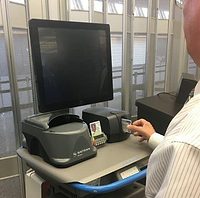Using biometrics to reinvent customer authentication

Fraudsters have long been taking advantage of customer service representatives, pretending to be someone they aren’t on the phone, over email, or over to chat to access accounts, information, and money. As the pandemic took hold and online engagements became even more frequent with people staying home over the last year, the number of fraud attempts began to rise as bad actors looked to take advantage of the fully digital environment. In fact, the Federal Trade Commission (FTC) estimates that—between stimulus checks and unemployment benefits—Americans have lost more than $3.3 billion in COVID-19 related fraud.
Even through the onslaught, organizations continue to rely on outdated authentication methods to determine identities—which not only leaves them susceptible to fraud, but also creates frustrating, time-consuming experiences for consumers. The customer service representative is required to ask countless questions used to confirm identity, including pins, passwords, contact information, account number, SSN, and answers to pre-set challenge questions. Forgetting an answer to just one of the questions can delay the process event further, as the agent won’t be able to authenticate the customer’s identity and, thus, cannot help them with their inquiry. And unfortunately, these methods aren’t the most effective in protecting against fraud; most—if not all—of this information can be sought after by fraudsters on the dark web and can be used to hack into an account regardless of the precautions.
While this interrogation process may prevent, or discourage, a fraudulent attack, it can also cause a lot of frustration with a legitimate customer who is unable to access their account. Enter AI-enabled biometrics, which has become a key combatant in the fight against deception for its ability to authenticate customers securely and accurately over the phone before they even reach a live agent. Not only can biometrics fight fraud, but the tool is also reinventing the customer experience. Here’s how.
Defining biometrics
Biometric authentication uses voice, conversation, and behavioral modalities to allow consumers to create their own virtual fingerprint. Examples of modalities include patterns in speech, the choice of words used, how a person types, or the way someone holds their cellphone. Biometrics compare the voice and behavior modalities to the customer’s existing voiceprint and can confirm whether someone is who they say they are within a half-second of speaking time, versus the 90 seconds or more it would take to ask and answer the identifying questions. Biometrics provide businesses with a frictionless, faster, and more secure way to authenticate identification than the traditional Q&A methods.
How biometrics can improve experience and security
With biometrics, the authentication solution will automatically analyze a customer’s unique features and characteristics against a pre-established profile to verify their identity. The company associate can be assured that the caller is who they say they are quickly and can proceed with resolving the account issue, leading to better customer experiences in a time of instant gratification and high customer expectations. No longer do customers have to go through the frustrating process of digging for a password or repeating the same information to several people and robots. This quick interaction also has an impact on hold times for other callers in the queue, speeding up the process for all.
In addition, the human voice is one of the safest and fastest ways to validate a person’s identity. Voiceprints are created from more than 1,000 voice characteristics; it is language agnostic, device agnostic, and channel agnostic. The artificial intelligence that powers a biometric solution can analyze those distinct voice characteristics, cross-checking the speaker’s unique device, channel identification, and speech patterns. The intelligence can also verify that the speaker is a live human being and not a recording or other artificial creation such as a deepfake. Biometrics stops takeover attempts in their tracks, giving customers and employees a peace of mind.
In addition to streamlining and securing the customer experience, biometrics can also improve employee experience, leading to lower stress levels and fewer burnout numbers. One study from PwC found that organizations with satisfied employees are also 82% more likely to provide a better customer experience. It’s a win-win situation for the customer and employee.
Biometrics in practice
Fraudsters have targeted one specific, vulnerable group of individuals more than others over this last year: seniors. According to a pre-COVID-19 analysis by the U.S. Consumer Financial Protection Bureau, people impacted greatest by fraudulent activity were ages 70 to 79—averaging a loss of $45,300.
Recognizing that senior citizens were particularly defenseless to fraud efforts, Telefónica, a global telecommunications firm, implemented AI-enabled intelligent age detection capabilities in its biometrics solution to help prioritize seniors who were more likely to call in with requests during strict lockdowns. The human ear typically cannot differentiate between a 50-year-old and a 70-year-old with any reasonable degree of precision. Working with Nuance, Telefonica implemented AI voice algorithms able to detect over 1,000 characteristics of the human voice, far more than a human could. The deep neural network-based AI algorithms were honed-in on a subset of these characteristics that are affected in a predictable way as humans age.
Within weeks, Telefónica’s senior customers were transferred immediately to a live agent, able to get faster, more personalized service, and could rest assured knowing their account information was secure. In a time of increased confusion and fraud attempts, this level of security and customer dedication helped the global telecommunications firm standout from competitors. This new factor is also a key factor in preventing fraud and elder abuse.
Fraudsters are getting smarter, and they’re working harder now that the world is predominantly digital thanks to remote work and stay-at-home orders. To combat those attacks while simultaneously creating frictionless experiences for customers, organizations need to update their security methods to invest in AI-enable biometrics. The result is not only enhanced security, but happier customers and employees.
Looking for a reprint of this article?
From high-res PDFs to custom plaques, order your copy today!






